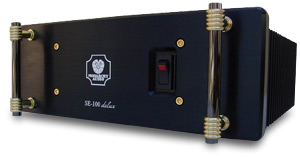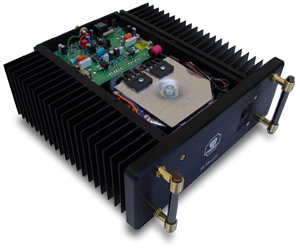![[SoundStage!]](../titles/sslogo3.gif) Home
Audio Home
Audio Equipment Review |
||||
When I reviewed the Monarchy Audio SM-70 Pro power amp last winter, I was knocked out by its performance, especially when used as balanced monoblocks. Although this doubled the amp's price, it also sounded fabulous -- fabulous enough to sound competitive with amps costing a lot more. If I felt the amp had even the tiniest shortcoming, it was that, at 80W, it could be, ahem, challenged by the brutal load represented by Thiel's CS7.2 -- a speaker with a nasty impedance drop/phase angle one-two punch in its lower frequencies. 'T ain't no shame in that -- it would be a far shorter job to list the amps that don't balk at the challenge presented by the CS7.2s. But Mr. C. C. Poon of Monarchy is justifiably proud of his diminutive amplifiers, and he wanted me to hear just how good they can sound -- even when driving impossible loads. He sent me, therefore, not just a pair of SE-100s, but two pairs. The SE-100s, you see, are 100W monoblocks -- but by wiring a pair of them just so, you can convert four of them to a balanced pair of 100W monoblocks capable of driving biwired or biamped loudspeakers with impedances below 2 ohms. Of course, for truly brutal loads, you need to keep a steady stream of air blowing over their heatsinks, but as long as you keep the amps cool and comfortable, they'll pump out as much juice as you need. Of course, by the time I received the SE-100s, I'd returned the Thiels to their maker, so I never did get a chance to hear what the amps and speakers sounded like together (and the CS7.2s don't accept biwiring anyway), but I decided to check out the amplifiers -- after all, SoundStage! had named them a Reviewers' Choice back in 1999.
Small but mighty I started my audition with a work that has become a bit of an obsession with me. I first heard it on Jonathan Schwartz's Saturday-afternoon show on WNYC, where it stopped me in my tracks. Against a shimmering background of restless strings and woodwinds playing over a slowly moving foundation of cellos and basses, I heard a sweet violin playing a descending four-note motif of heart-rending nobility. That luscious fiddle was weaving in and out of a massed-string forest, alternating with lovely French-horn solos. In its cheerful, pastoral exuberance, it sounded like a Vaughan Williams concerto I'd never heard before. But it wasn't; it was James Horner's score for Iris [Sony Classical SK-89806]. Wait a minute. I have that record! I rifled madly through my stack of promo CDs waiting to be played and plucked it out. It's even better than it sounded on the radio. Recorded at Lyndehurst Studios and Abbey Road Studios, it has that luscious, airy sound audiophiles will recognize from so many mid-'70s Deccas. And Joshua Bell's violin solos sound so sweet and light, they seem to hover several feet above the other instruments as though aching to take flight. Yup. The SE-100 Delux amps report all that without adding a hint of grain or tizz. The strings sound delicate and quite airy, while the overtones of Bell's solo lines simply sing. I was also impressed with the heft and clarity of those cello and bass whole-note lines, which ground the string sound without nailing it down. They remain in motion, but the sound is clear and you can "see" clear to the bottom of the score without encountering a speck of muddiness. I also listened to Cristal: Glass Music Through the Ages [Sony Classical SK 89047], Dennis James' recording of armonica music. Essentially an instrument consisting of rotating tuned bowls which are "played" by pressing a finger against their rims as they rotate -- think of running your finger around the rim of a crystal wine goblet -- the armonica has a piercing, unearthly sound that sounds almost entirely comprised of overtones. The armonica has a sound that some people just can't take, but if you wish to hear how well a system reproduces pure high frequencies, there's nothing quite like it. And the SE-100 Delux portrayed the sound of the armonica is all its sloppy, clanging glory -- I knew it was working when my wife ran from the room screaming. I also decided to check out the overall soundstaging and deep-bass response of the little cuties with Echoes: The Best of Pink Floyd [EMI CDP 36111-2 ], specifically "One of These Days," whose deep bass throb literally caused the Dynaudio Evidence Temptations to flex the house's walls. This is bass that is felt more than heard -- a pressure wave that is sensed by your entire skin, not just your eardrums. Not bad performance for a 9" by 4" by 12" box. Two much fun The Dynaudio Evidence Temptations are not a simple load to drive -- but they are a far cry from the Thiel CS7.2s. The Monarchy SE-100 Deluxes had no trouble driving the Temptations during my audition, no matter what I threw at them. Still, Mr. Poon had sent me four of the amps so I could biamp a speaker with them, so I needed to find a speaker with biwiring capabilities. Enter the Polk LSi15s. With a single pair of SE-100s Deluxes, the Polks sang like champions. I wasn't quite prepared for what they sounded like with two pairs. What you do is this: Take a pair of SE-100s and connect one of them to your preamp using either the single-ended RCA or the balanced XLR connection; take whichever input you didn't use and connect it to the same input of the other amp; now connect one amp to the tweeter/midrange binding posts of the speaker and the other amp to the woofer's binding posts. You have now passively biamped your loudspeakers. The difference was not subtle. The Polks sounded even more authoritative, which I sort of expected. They also sounded even sweeter and purer through the highs and mids. More refined, if you like. And like it, I did! Small wonders The Monarchy SE-100 Delux monoblocks are superb amplifiers. They are well built and offer high-end sound that is sweetly detailed and authoritative. Their small size offers placement advantages over larger amps and, through their ability to be joined for biamped operation, they offer an upgrade path that may be easier for many audiophiles to take advantage of than the traditional trade-up route -- where you can lose equity as you trade up. If you're looking for good-sounding power amplifiers in the $2000-$3000 range, audition the Monarchys. They lack a bit of the ineffable musicality of the very highest of the high-end amplifiers, but given the cost differential, many audiophiles may consider that level of performance beyond the point of diminishing returns. That's one charge that could never be laid at the feet of the SE-100 Delux amps. They may be small, but they're choice. ...Wes Phillips
|
||||
|
||||
![[SoundStage!]](../titles/sslogo3.gif) All
Contents All
ContentsCopyright © 2002 SoundStage! All Rights Reserved |


 There have been a few circuit
modifications to the amp since we last reviewed it, specifically changes to its input
section, which were intended to smooth out its high-frequency response, and some other
changes to the amplification circuit itself. But SoundStage! reported that the
SE-100s were "very satisfying and musical amplifiers," and that's what I
thought, too.
There have been a few circuit
modifications to the amp since we last reviewed it, specifically changes to its input
section, which were intended to smooth out its high-frequency response, and some other
changes to the amplification circuit itself. But SoundStage! reported that the
SE-100s were "very satisfying and musical amplifiers," and that's what I
thought, too.